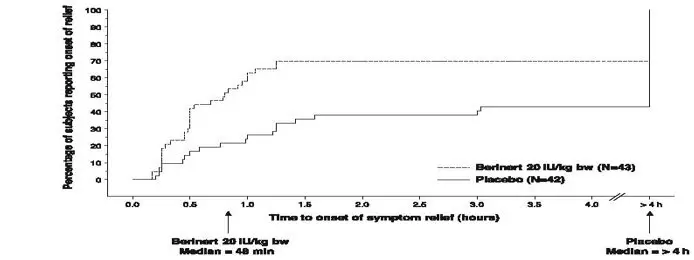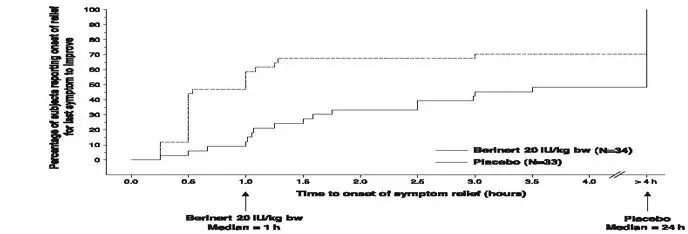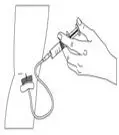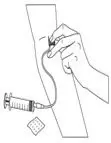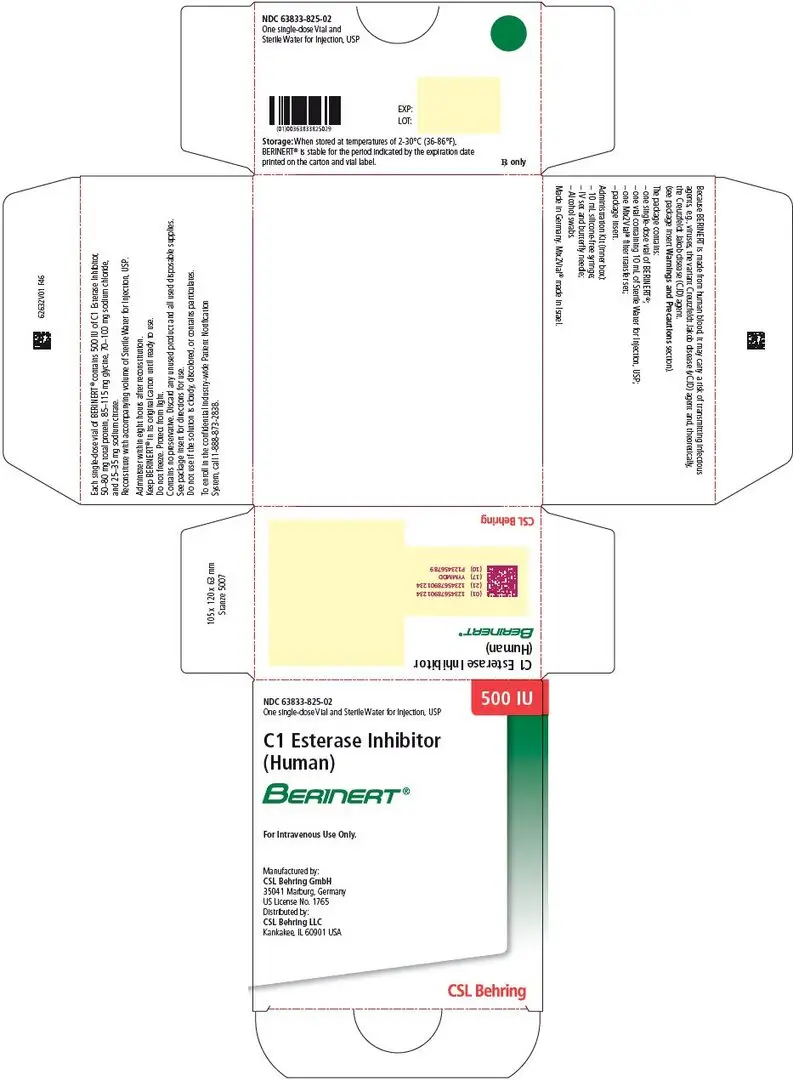Drug Detail:Berinert (Complement c1 esterase inhibitor [ kom-ple-ment-c1 es-ter-ase-in-hib-it-or ])
Drug Class: Hereditary angioedema agents
Highlights of Prescribing Information
BERINERT [C1 Esterase Inhibitor (Human)]
For intravenous use. Freeze-Dried Powder for Reconstitution.
Initial U.S. Approval: 2009
Recent Major Changes
| Dosage and Administration (2.1) | 09/2021 |
Indications and Usage for Berinert
BERINERT is a plasma-derived C1 Esterase Inhibitor (Human) indicated for the treatment of acute abdominal, facial, or laryngeal hereditary angioedema (HAE) attacks in adult and pediatric patients. (1)
The safety and efficacy of BERINERT for prophylactic therapy have not been established. (1)
Berinert Dosage and Administration
For intravenous use only.
- Store the vial in the original carton in order to protect from light. Store at 2-30°C (36-86°F). Do not freeze. (2)
- Administer 20 International Units per kg body weight. (2)
- Reconstitute BERINERT prior to use using the Sterile Water for Injection, USP provided. (2.1)
- Use the silicone-free syringe provided for administration of BERINERT. (2.1)
- Administer at room temperature within 8 hours of reconstitution. (2.1)
- Inject at a rate of approximately 4 mL per minute. (2.2)
- Do not mix BERINERT with other medicinal products or solutions. (2.2)
- Appropriately trained patients may self-administer upon recognition of an HAE attack. (2.2)
Dosage Forms and Strengths
500 International Units lyophilized concentrate in a single-dose vial for reconstitution with 10 mL of Sterile Water for Injection, USP. (3)
Contraindications
Do not use in patients with a history of life-threatening immediate hypersensitivity reactions, including anaphylaxis, to C1 esterase inhibitor preparations. (4)
Warnings and Precautions
- Hypersensitivity reactions may occur. Epinephrine should be immediately available to treat any acute severe hypersensitivity reactions following discontinuation of administration. (5.1)
- Serious arterial and venous thromboembolic (TE) events have been reported at the recommended dose of C1 Esterase Inhibitor (Human) products, including BERINERT, following administration in patients with HAE. Risk factors may include the presence of an indwelling venous catheter/access device, prior history of thrombosis, underlying atherosclerosis, use of oral contraceptives or certain androgens, morbid obesity, and immobility. Benefits of treatment of HAE attacks should be weighed against the risks of TE events in patients with underlying risk factors. Monitor patients with known risk factors for TE events during and after BERINERT administration.
TE events have also been reported following administration of a C1 Esterase Inhibitor (Human) product when used for unapproved indications at higher than recommended doses.1 (5.2) - Because BERINERT is made from human blood, it may carry a risk of transmitting infectious agents, e.g., viruses, the variant Creutzfeldt-Jakob disease (vCJD) agent and, theoretically, the Creutzfeldt-Jakob disease (CJD) agent. (5.3)
- Laryngeal HAE attacks: Following self-administration of BERINERT for laryngeal HAE attacks, advise patients to immediately seek medical attention. (5.4)
Adverse Reactions/Side Effects
- The most serious adverse reaction reported in subjects who received BERINERT was an increase in the severity of pain associated with HAE. (6.1)
- The most common adverse reaction reported in greater than 4% of the subjects and greater than placebo among subjects who received BERINERT in the placebo-controlled clinical trial was dysgeusia. (6.1)
To report SUSPECTED ADVERSE REACTIONS, contact the CSL Behring Pharmacovigilance Department at 1-866-915-6958 or to the FDA at 1-800-FDA-1088 or www.fda.gov/medwatch.
Use In Specific Populations
- Pregnancy: Use only if clearly needed. (8.1)
- Compared to adults, when adjusted for baseline, the half-life of BERINERT was shorter and clearance (on per kg basis) was faster in children. The clinical implication of this difference is not known. (12.3)
See 17 for PATIENT COUNSELING INFORMATION and FDA-approved patient labeling.
Revised: 9/2021
Related/similar drugs
Firazyr, Haegarda, Cinryze, Ruconest, Kalbitor, Takhzyro, stanozololFull Prescribing Information
1. Indications and Usage for Berinert
BERINERT is a plasma-derived concentrate of C1 Esterase Inhibitor (Human) indicated for the treatment of acute abdominal, facial, or laryngeal hereditary angioedema (HAE) attacks in adult and pediatric patients.
The safety and efficacy of BERINERT for prophylactic therapy have not been established.
2. Berinert Dosage and Administration
For intravenous use only.
Administer BERINERT at a dose of 20 International Units (IU) per kg body weight by intravenous injection. Doses lower than 20 IU/kg body weight should not be administered.
BERINERT is provided as a freeze-dried powder for reconstitution with the Sterile Water for Injection, USP provided. Store the vial in the original carton in order to protect from light. Do not freeze.
2.1 Preparation and Handling
- Check the expiration date on the product vial label and on the administration kit. Do not use any component that is beyond the expiration date. Do not use if any components are damaged or opened.
- Prepare and administer using aseptic techniques [see Dosage and Administration (2.2)].
- Use the silicone-free syringe, provided, for administration of BERINERT [see How Supplied/Storage and Handling (16)].
- After reconstitution and prior to administration, inspect BERINERT visually for particulate matter and discoloration. The reconstituted solution should be colorless, clear, and free from visible particles. Do not use if the solution is cloudy, discolored, or contains particulates.
- The BERINERT vial is for single use only. BERINERT contains no preservative. Any product that has been reconstituted should be used promptly. The reconstituted solution must be used within 8 hours. Discard partially used vials.
- Do not freeze the reconstituted solution.
2.2 Reconstitution and Administration
Each BERINERT vial containing 500 IU of C1 esterase inhibitor as a lyophilized concentrate for reconstitution with 10 mL of Sterile Water for Injection, USP provided.
Use either the Mix2Vial® transfer set provided with BERINERT [see How Supplied/Storage and Handling (16.1)] or a commercially available double-ended needle and vented filter spike.
3. Dosage Forms and Strengths
- BERINERT is available in a single-dose vial that contains 500 IU of C1 esterase inhibitor as a lyophilized concentrate.
- Each vial must be reconstituted with 10 mL of Sterile Water for Injection, USP provided.
4. Contraindications
BERINERT is contraindicated in individuals who have experienced life-threatening hypersensitivity reactions, including anaphylaxis, to C1 esterase inhibitor preparations.
5. Warnings and Precautions
5.1 Hypersensitivity
Severe hypersensitivity reactions may occur. Epinephrine should be immediately available for treatment of acute severe hypersensitivity reaction [see Patient Counseling Information (17)]. The signs and symptoms of hypersensitivity reactions may include hives, generalized urticaria, tightness of the chest, wheezing, hypotension, and/or anaphylaxis during or after injection of BERINERT.
Because hypersensitivity reactions may have symptoms similar to HAE attacks, treatment methods should be carefully considered. In case of suspected hypersensitivity, immediately discontinue administration of BERINERT and institute appropriate treatment.
5.2 Thromboembolic Events
Serious arterial and venous thromboembolic (TE) events have been reported at the recommended dose of C1 Esterase Inhibitor (Human) products, including BERINERT, following administration in patients with HAE. Risk factors may include the presence of an indwelling venous catheter/access device, prior history of thrombosis, underlying atherosclerosis, use of oral contraceptives or certain androgens, morbid obesity, and immobility. Benefits of treatment of HAE attacks should be weighed against the risks of TE events in patients with underlying risk factors. Monitor patients with known risk factors for TE events during and after BERINERT administration.
TE events have also been reported following administration of a C1 Esterase Inhibitor (Human) product when used for unapproved indications at higher than recommended doses1,2 [see Overdosage (10) and Nonclinical Toxicology (13.2)].
5.3 Transmissible Infectious Agents
Because BERINERT is made from human blood, it may carry a risk of transmitting infectious agents, e.g., viruses, the variant Creutzfeldt-Jakob disease (vCJD) agent and, theoretically, the Creutzfeldt-Jakob disease (CJD) agent. The risk that such products will transmit an infectious agent has been minimized by screening plasma donors for prior exposure to certain viruses, by testing for the presence of certain current virus infections, and by processes demonstrated to inactivate and/or remove a wide range of viruses [see Description (11)].
Despite these measures, such products may still potentially transmit disease and there is also the possibility that unknown infectious agents may be present in such products. However, since implementation of these measures, no case reports on suspected transmission of viruses have demonstrated a causal relationship to the administration of BERINERT.
All infections thought by a physician possibly to have been transmitted by BERINERT should be reported by lot number, by the physician, or other healthcare provider to the CSL Behring Pharmacovigilance Department at 1-866-915-6958.
6. Adverse Reactions/Side Effects
The most serious adverse reaction reported in subjects enrolled in clinical studies who received BERINERT was an increase in the severity of pain associated with HAE.
The most common adverse reaction reported in greater than 4% of the subjects and greater than placebo among subjects who received BERINERT in the placebo-controlled clinical trial was dysgeusia.
6.1 Clinical Trials Experience
Because clinical studies are conducted under widely varying conditions, adverse reaction rates observed in the clinical trials of a drug cannot be directly compared to rates in the clinical trials of another drug and may not reflect the rates observed in practice.
6.2 Immunogenicity
In a post-marketing study forty-six subjects with Type I or Type II HAE were monitored for inhibitory or non-inhibitory antibodies to C1-INH. Blood samples for antibody assessment were taken at Day 1 (First HAE attack requiring administration of a dose of 20 IU/kg IV, baseline value), and at 3, 6 and 9 months. No subjects developed inhibitory antibodies to C1-INH at any of the time points following infusion of BERINERT. Thirteen subjects (28.2%), however, had detectable levels of non-inhibitory Abs at some point during the study, including 9 subjects (19.6%) who had detectable non-inhibitory Abs at baseline. The presence of non-inhibitory anti-C1-INH Abs did not induce apparent immunologically-associated clinical events.
The detection of antibody formation is highly dependent on the sensitivity and specificity of the assay. Additionally, the observed incidence of antibody (including neutralizing antibody) positivity in an assay may be influenced by several factors including assay methodology, sample handling, timing of sample collection, concomitant medications, and underlying disease. For these reasons, it may be misleading to compare the incidence of antibodies to BERINERT in the studies described above with the incidence of antibodies in other studies or to other products.
6.3 Postmarketing Experience
Because postmarketing reporting of adverse reactions is voluntary and from a population of uncertain size, it is not always possible to reliably estimate the frequency of these reactions or establish a causal relationship to product exposure.
Adverse reactions reported in Europe since 1979 in patients receiving BERINERT for treatment of HAE include hypersensitivity/anaphylactic reactions, injection-site pain, injection-site redness, chills, and fever.
8. Use In Specific Populations
8.4 Pediatric Use
Safety and efficacy of BERINERT have been evaluated in 12 pediatric patients with HAE (age range 10 to 16 years) in the placebo controlled and open-label extension studies. BERINERT was also evaluated in 18 pediatric patients with HAE (age range 5 to 11 years) in a Registry Study conducted in the US and Europe. The safety profile observed in the pediatric population was similar to that observed in adults. The pharmacokinetics of BERINERT were evaluated in 5 pediatric subjects (ages 6 through 13) [see Clinical Pharmacology (12.3)].
8.5 Geriatric Use
The safety and efficacy of BERINERT in the geriatric population have not been evaluated in controlled clinical studies. BERINERT was evaluated in 27 geriatric subjects (age range 65 to 83 years) with HAE in a Registry Study conducted in the US and Europe. The safety profile observed in the geriatric population was similar to that observed in the younger populations studied.
10. Overdosage
The development of thrombosis has been reported after doses exceeding 20 IU/kg body weight of BERINERT when used for unapproved indications in newborns and young children with congenital heart anomalies during or after cardiac surgery under extracorporeal circulation.1
The maximum dose administered in clinical studies in hereditary angioedema was 20 IU/kg body weight.
11. Berinert Description
BERINERT is a human plasma-derived, purified, pasteurized, lyophilized concentrate of C1 esterase inhibitor to be reconstituted for intravenous administration. BERINERT is prepared from large pools of human plasma from US donors. The potency of C1 esterase inhibitor is expressed in International Units (IU), which is related to the current WHO Standard for C1 esterase inhibitor products.
C1 esterase inhibitor is a soluble, single-chain glycoprotein containing 478 amino acid residues organized into three beta-sheets and eight or nine alpha-helices.4 The heavily glycosylated molecule has an apparent molecular weight of 105 kD, of which the carbohydrate chains comprise 26% to 35%.5
Each 500 IU vial of reconstituted BERINERT contains 400-625 IU C1 esterase inhibitor, 50 to 80 mg total protein, 85 to 115 mg glycine, 70 to 100 mg sodium chloride, and 25 to 35 mg sodium citrate.
All plasma used in the manufacture of BERINERT is obtained from US donors and is tested using serological assays for hepatitis B surface antigen and antibodies to HIV-1/2 and HCV. Additionally, the plasma is tested with Nucleic Acid Testing (NAT) for HBV, HCV, HIV-1 and HAV and found to be non-reactive (negative). In addition, the plasma is also tested by NAT for Human Parvovirus B19. Only plasma that has passed virus screening is used for production, and the limit for Parvovirus B19 in the fractionation pool is set not to exceed 104 IU of Parvovirus B19 DNA per mL.
The manufacturing process for BERINERT includes multiple steps that reduce the risk of virus transmission. The virus inactivation/reduction capacity consists of three steps:
- Pasteurization in aqueous solution at 60°C for 10 hours
- Hydrophobic interaction chromatography
- Virus filtration (also called nanofiltration) by two filters, 20 nm and 15 nm, in series
This was evaluated in a series of in vitro spiking experiments. The total mean cumulative virus inactivation/reduction is shown in Table 2.
| Virus Studied | Pasteurization [log10] | Hydrophobic Interaction Chromatography [log10] | Virus Filtration [log10] | Total Cumulative [log10] |
|---|---|---|---|---|
| HIV-1, Human immunodeficiency virus type 1, a model for HIV-1 and HIV-2 | ||||
| BVDV, Bovine viral diarrhea virus, a model for HCV | ||||
| PRV, Pseudorabies virus, a model for large enveloped DNA viruses | ||||
| WNV, West Nile virus | ||||
| HAV, Hepatitis A virus | ||||
| CPV, Canine parvovirus | ||||
| B19V, Human Parvovirus B19 | ||||
| ND, Not determined | ||||
| NA, Not applicable | ||||
| Enveloped Viruses | ||||
| HIV-1 | ≥6.6 | ≥4.5 | ≥5.1 | ≥16.2 |
| BVDV | ≥9.2 | ≥4.7 | ≥5.3 | ≥19.2 |
| PRV | 6.3 | ≥6.5 | ≥7.1 | ≥19.9 |
| WNV | ≥7.0 | ND | ≥8.0 | ≥15.0 |
| Non-Enveloped Viruses | ||||
| HAV | ≥6.4 | 2.8 | ≥5.3 | ≥14.5 |
| CPV | 1.4 | 3.9 | 7.1 | 12.4 |
| B19V | 3.9 | ND | ND | NA |
12. Berinert - Clinical Pharmacology
12.1 Mechanism of Action
C1 esterase inhibitor is a normal constituent of human plasma and belongs to the group of serine protease inhibitors (serpins) that includes antithrombin III, alpha1-protease inhibitor, alpha2-antiplasmin, and heparin cofactor II. As with the other inhibitors in this group, C1 esterase inhibitor has an important inhibiting potential on several of the major cascade systems of the human body, including the complement system, the intrinsic coagulation (contact) system, the fibrinolytic system, and the coagulation cascade. Regulation of these systems is performed through the formation of complexes between the proteinase and the inhibitor, resulting in inactivation of both and consumption of the C1 esterase inhibitor.
C1 esterase inhibitor, which is usually activated during the inflammatory process, inactivates its substrate by covalently binding to the reactive site. C1 esterase inhibitor is the only known inhibitor for the subcomponent of the complement component 1 (C1r), C1s, coagulation factor XIIa, and kallikrein. Additionally, C1 esterase inhibitor is the main inhibitor for coagulation factor XIa of the intrinsic coagulation cascade.
HAE patients have low levels of endogenous or functional C1 esterase inhibitor. Although the events that induce HAE attacks of angioedema in HAE patients are not well defined, it has been postulated that increased vascular permeability and the clinical manifestation of HAE attacks may be primarily mediated through contact system activation. Suppression of contact system activation by C1 esterase inhibitor through the inactivation of plasma kallikrein and factor XIIa is thought to modulate this vascular permeability by preventing the generation of bradykinin.6
Administration of BERINERT to patients with C1 esterase inhibitor deficiency replaces the missing or malfunctioning protein in patients. The plasma concentration of C1 esterase inhibitor in healthy volunteers is approximately 270 mg/L.7
12.3 Pharmacokinetics
The pharmacokinetics of BERINERT were evaluated in an open-label, uncontrolled, single-center study in 40 subjects (35 adults and 5 children under 16 years of age) with either mild or severe HAE. All subjects received a single intravenous injection of BERINERT ranging from 500 IU to 1500 IU. Blood samples were taken during an HAE attack-free period at baseline and for up to 72 hours after drug administration. Pharmacokinetic parameters were estimated using non-compartmental analysis (with or without baseline adjustment). Table 3 summarizes the pharmacokinetic parameters in 35 adult subjects with HAE.
| Parameters | Unadjusted for baseline | Adjusted for baseline |
|---|---|---|
| AUC: Area under the curve | ||
| CL: Clearance | ||
| Vss: Volume steady state | ||
| MRT: Mean residence time | ||
|
||
| AUC(0-t) (hr × IU/mL)* | 27.5 ± 8.5 (15.7-44.7) | 12.8 ± 6.7 (3.9-34.7) |
| CL (mL/hr/kg) | 0.60 ± 0.17 (0.34-0.96) | 1.44 ± 0.67 (0.43-3.85) |
| Vss (mL/kg) | 18.6 ± 4.9 (11.1-27.6) | 35.4 ± 10.5 (14.1-56.1) |
| Half-life (hrs) | 21.9 ± 1.7 (16.5-24.4) | 18.4 ± 3.5 (7.4-22.8) |
| MRT (hrs) | 31.5 ± 2.4 (23.7-35.2) | 26.4 ± 5.0 (10.7-33.0) |
Table 4 summarizes the pharmacokinetic parameters in 5 pediatric subjects (ages 6 through 13) with HAE. When adjusted for baseline, compared to adults, the half-life of BERINERT was shorter and clearance (on per kg basis) was faster in this limited cohort of children. However, the clinical implication of this difference is not known.
| Parameters | Unadjusted for baseline | Adjusted for baseline |
|---|---|---|
| AUC: Area under the curve | ||
| CL: Clearance | ||
| Vss: Volume steady state | ||
| MRT: Mean residence time | ||
|
||
| AUC(0-t) (hr × IU/mL)† | 25.45 ± 5.8 (16.8-31.7) | 9.78 ± 4.37 (4.1-15.2) |
| CL (mL/hr/kg) | 0.62 ± 0.17 (0.47-0.89) | 1.9 ± 1.1 (0.98-3.69) |
| Vss (mL/kg) | 19.8 ± 4.0 (16.7-26.1) | 38.8 ± 8.9 (31.9-54.0) |
| Half-life (hrs) | 22.4 ± 1.6 (20.3-24.4) | 16.7 ± 5.8 (7.4-22.5) |
| MRT (hrs) | 32.3 ± 2.3 (29.3-35.2) | 24.0 ± 8.3 (10.7-32.4) |
Studies have not been conducted to evaluate the pharmacokinetics of BERINERT in special patient populations identified by gender, race, geriatric age, or the presence of renal or hepatic impairment.
13. Nonclinical Toxicology
13.1 Carcinogenesis, Mutagenesis, Impairment of Fertility
No animal studies have been completed to evaluate the effects of BERINERT on carcinogenesis, mutagenesis, and impairment of fertility.
13.2 Animal Toxicology and/or Pharmacology
Acute intravenous toxicity of BERINERT was performed in mice at 1500, 3000, and 6000 IU/kg and in rats at 1000, 2000, and 3000 IU/kg. BERINERT was well tolerated and no signs of toxicity were observed up to the highest dose administered.
Repeat intravenous dose toxicity was studied in a 14-day repeat dose study in rats at doses of 20, 60, and 200 IU/kg/day. BERINERT was well tolerated and no toxicity was observed up to the highest dose administered. No antibody response against C1 esterase inhibitor could be demonstrated in this study after multiple dosing with BERINERT.
In a safety pharmacology study, BERINERT was administered to beagle dogs intravenously at a cumulative dose of 3500 IU/kg. No adverse effects were seen on the cardiovascular and respiratory system. There was a drop in body temperature, reduced coagulation time, and a decrease in thrombocyte aggregation.
Local intravenous tolerance of BERINERT was evaluated in rabbits at 1500 IU. No pathological changes were noted at the time of injection or during the following 24 hours. No pathological signs were noted during necropsy.
A study in pigs investigating cardioprotective effects of C1 esterase inhibitor suggests a risk of thrombosis from intravenous administration of C1 esterase inhibitor products at doses of 200 IU/kg; however, in this model, cardioprotective effects were observed at a dose of 40 IU/kg.2
14. Clinical Studies
The safety and efficacy of BERINERT in the treatment of acute abdominal or facial HAE attacks in subjects with hereditary angioedema were demonstrated in a placebo-controlled, double-blind, prospective, multinational, randomized, parallel-group, dose-finding, three-arm, clinical study, referred to as the randomized clinical trial (RCT). The RCT assessed the efficacy and safety of BERINERT in 124 adult and pediatric subjects with C1 esterase inhibitor deficiency who were experiencing an acute moderate to severe attack of abdominal or facial HAE. Subjects ranged in age from six to 72 years of age; 67.7% were female and 32.3% were male; and approximately 90% were Caucasian.
The study objectives were to evaluate whether BERINERT shortens the time to onset of relief of symptoms of an abdominal or facial HAE attack compared to placebo and to compare the efficacy of two different doses of BERINERT. The time to onset of relief of symptoms was determined by the subject's response to a standard question posed at appropriate time intervals for as long as 24 hours after start of treatment, taking into account all single HAE symptoms. In addition, the severity of individual HAE symptoms was assessed over time.
Subjects were randomized to receive a single 10 IU/kg body weight dose of BERINERT (39 subjects), a single 20 IU/kg dose of BERINERT (43 subjects), or a single dose of placebo (42 subjects) by slow intravenous infusion (recommended to be given at a rate of approximately 4 mL per minute) within 5 hours of an HAE attack. At least 70% of the subjects in each treatment group were required to be experiencing an abdominal HAE attack.
If a subject experienced no relief or insufficient relief of symptoms by 4 hours after infusion, investigators had the option to administer a second infusion of BERINERT (20 IU/kg for the placebo group, 10 IU/kg for the 10 IU/kg group), or placebo (for the 20 IU/kg group). This masked (blinded) "rescue study medication" was administered to subjects and they were then followed until complete resolution of symptoms was achieved. Adverse events were collected for up to 7 to 9 days following the initial administration of BERINERT or placebo.
In the rare case that a subject developed life-threatening laryngeal edema after inclusion into the study, immediate start of open-label treatment with a 20 IU/kg body weight dose of BERINERT was allowed.
All subjects who received confounding medication (rescue medication) before symptom relief were regarded as "non-responders". Therefore, time to onset of symptom relief was set at 24 hours if a subject received any rescue medication (ie, rescue study medication, narcotic analgesics, non-narcotic analgesics, anti-emetics, open-label C1 inhibitor, androgens at increased dose, or fresh frozen plasma) between 5 hours before administration of blinded study medication until time to onset of relief.
For the trial to be considered successful, the study protocol specified the following criteria for the differences between the BERINERT 20 IU/kg and the placebo group:
- The time to onset of relief of symptoms of the HAE attack had to achieve a one-sided p-value of less than 0.0249 for the final analysis, and at least one of the following criteria had to demonstrate a trend in favor of BERINERT with a one-sided p-value of less than 0.1:
- The proportion of subjects with increased intensity of clinical HAE symptoms between 2 and 4 hours after start of treatment with study medication compared to baseline, or
- The number of vomiting episodes within 4 hours after start of study treatment.
Subjects treated with 20 IU/kg body weight of BERINERT experienced a significant reduction (p=0.0016; "Wilcoxon Rank Sum test") in time to onset of relief from symptoms of an HAE attack as compared to placebo (median of 48 minutes for BERINERT 20 IU/kg body weight, as compared to a median of >4 hours for placebo). The time to onset of relief from symptoms of an HAE attack for subjects in the 10 IU/kg dose of BERINERT was not statistically significantly different from that of subjects in the placebo group.
Figure 9 is a Kaplan-Meier curve showing the percentage of subjects reporting onset of relief of HAE attack symptoms as a function of time. Individual time points beyond 4 hours are not presented on the graph because the protocol permitted blinded rescue medication, analgesics, and/or anti-emetics to be administered starting 4 hours after randomized blinded study medication had been administered.
|
| Figure 9. Time to Onset of Symptom Relief with Imputation to >4 hours for subjects Who Received any Rescue Medication* or Non-narcotic Analgesics Before Start of Relief |
|
|
In addition, the efficacy of BERINERT 20 IU/kg body weight could be confirmed by observing a reduction in the intensity of single HAE symptoms at an earlier time compared to placebo. For abdominal attacks Figure 10 shows the time to start of relief of the last symptom to improve that was already present at baseline. Pre-defined abdominal HAE symptoms included pain, nausea, vomiting, cramps and diarrhea. Figure 11 shows the respective time to start of relief of the first symptom to improve that was already present at baseline.
|
| Figure 10. Time to Start of Relief of the Last Symptom to Improve (Abdominal HAE Attacks) with Imputation to >4 hours for subjects Who Received any Rescue Medication* Before Start of Relief |
|
|
|
| Figure 11. Time to Start of Relief of the First Symptom to Improve (Abdominal HAE Attacks) with Imputation to >4 hours for subjects Who Received Any Rescue Medication* Before Start of Relief |
|
|
For facial attacks, single HAE symptoms were recorded. In addition, photos were taken at pre-determined time points and assessed by the members of an independent Data Safety Monitoring Board (DSMB), who were blinded as to treatment, center and other outcome measures. The change in the severity of the edema when compared to baseline was assessed on a scale with outcomes "no change", "better", "worse" and "resolved". Figure 12 shows the time to start of relief from serial facial photographs by DSMB assessment.
|
| Figure 12. Time to Start of Relief from Serial Facial Photographs* |
|
|
Table 5 compares additional endpoints, including changes in HAE symptoms and use of rescue medication in subjects receiving BERINERT at 20 IU/kg body weight and placebo.
| Additional Endpoints | Number (%) of subjects BERINERT 20 IU/kg Body Weight Group (n=43) | Number (%) of subjects Placebo Group (n=42) |
|---|---|---|
|
||
| Onset of symptom relief within 60 minutes after administration of study medication (post-hoc) | 27 (62.8%) | 11 (26.2%) |
| Onset of symptom relief within 4 hours after administration of study medication | 30 (69.8%) | 18 (42.9%) |
| Number of vomiting episodes within 4 hours after start of study treatment* | 6 episodes | 35 episodes |
| Worsened intensity of clinical HAE symptoms between 2 and 4 hours after administration of study medication compared to baseline† | 0 (0%) | 12 (28.6%) |
| Number (percent) of combined abdominal and facial HAE attack subjects receiving rescue study medication, analgesics, or anti-emetics at any time prior to initial relief of symptoms | 13 (30.2%) | 23 (54.8%) |
| At least one new HAE symptom not present at baseline and starting within 4 hours after administration of study medication | 2 (4.6%) | 6 (14.3%) |
Both the proportion of subjects with increased intensity of clinical HAE symptoms between 2 and 4 hours after start of treatment compared to baseline, and the number of vomiting episodes within 4 hours after start of study treatment demonstrated trends in favor of BERINERT in comparison to placebo (p-values <0.1). Tables 6 through 9 present additional information regarding responses to treatment.
| HAE Attack Type | BERINERT 20 IU/kg Body Weight (Abdominal subjects = 34) (Facial subjects = 9) (Other subjects = 0) | Placebo Group (Abdominal subjects = 33) (Facial subjects = 8) (Other subjects = 1)* |
|---|---|---|
|
||
| Abdominal | 24 (70.6%) | 15 (45.5%) |
| Facial | 6 (66.7%) | 3 (37.5%) |
| HAE Attack Type | BERINERT 20 IU/kg Body Weight (Abdominal subjects = 34) (Facial subjects = 9) | Placebo Group (Abdominal subjects = 33) (Facial subjects = 8) |
|---|---|---|
| Abdominal | 33 (97.1%) | 29 (87.9%) |
| Facial | 6 (66.7%) | 4 (50%) |
| Attack Type | BERINERT 20 IU/kg Body Weight (Subjects = 9) | Placebo Group (Subjects = 8) |
|---|---|---|
|
||
| Facial | 7 (77.8%) | 2 (25%) |
| HAE Attack Type | BERINERT 20 IU/kg Body Weight | Placebo Group |
|---|---|---|
| (Abdominal subjects = 34) (Facial subjects = 9) | (Abdominal subjects = 33) (Facial subjects = 8) |
|
| Abdominal | 7 (20.6%) | 17 (51.5%) |
| Facial | 1 (11.1%) | 6 (75%) |
No subjects treated with BERINERT at 20 IU/kg body weight reported worsening of symptoms at 4 hours after administration of study medication compared to baseline.
The study demonstrated that the BERINERT 20 IU/kg body weight dose was significantly more efficacious than the BERINERT 10 IU/kg body weight dose or placebo.
15. References
- German Medical Profession's Drugs Committee. Severe thrombus formation of BERINERT® HS. Deutsches Ärzteblatt. 2000;97:B-864.
- Horstick, G et al. Application of C1-Esterase Inhibitor During Reperfusion of Ischemic Myocardium: Dose-Related Beneficial Versus Detrimental Effects. Circulation. 2001;104:3125-3131.
- Martinez-Saguer I, Rusicke E, Aygören-Pürsün E, et al. Characterization of acute hereditary angioedema attacks during pregnancy and breast-feeding and their treatment with C1 inhibitor concentrate. Am J Obstet Gynecol. 2010;203:131.e1-7.
- Carrell RW, Boswell DR. Serpins: the superfamily of plasma serine proteinase inhibitors. In: Barrett A, Salvesen G, eds. Proteinase Inhibitors. Amsterdam: Elsevier. 1986;12:403-420.
- Harrison RA. Human C1 inhibitor: Improved isolation and preliminary structural characterization. Biochemistry 1983;22:5001-5007.
- Davis AE, The pathophysiology of hereditary angioedema. Clin Immunol. 2005;114:3-9.
- Nuijens JH, Eerenberg-Belmer AJM, Huijbregts CCM, et al. Proteolytic inactivation of plasma C1 inhibitor in sepsis. J Clin Invest. 1989;84:443-450.
- Bork K, Barnstedt SE. Treatment of 193 Episodes of Laryngeal Edema with C1 Inhibitor Concentrate in Patients with Hereditary Angioedema. Arch Intern Med. 2001;161:714-718.
16. How is Berinert supplied
- BERINERT is supplied in a single-dose vial together with an administration kit.
- 500 IU vial of BERINERT for reconstitution with 10 mL of Sterile Water for Injection, USP.
- The components used in the packaging for BERINERT are not made with natural rubber latex.
Each product presentation includes a package insert and the following components:
| Carton NDC Number | Components | |
|---|---|---|
| 500 IU | 63833-825-02 |
|
17. Patient Counseling Information
Advise the patients to read the FDA-approved patient labeling (Patient Information).
Inform patients to immediately report the following to their physician:
- Signs and symptoms of allergic hypersensitivity reactions, such as hives, urticaria, tightness of the chest, wheezing, hypotension and/or anaphylaxis experienced during or after injection of BERINERT [see Warnings and Precautions (5.1)]
- Signs and symptoms of a thromboembolic event including pain and/or swelling of an arm or leg with warmth over the affected area, discoloration of an arm or leg, unexplained shortness of breath, chest pain or discomfort that worsens on deep breathing, unexplained rapid pulse, numbness or weakness on one side of the body. Advise patients with known risk factors for thromboembolic events that they are at an increased risk for these events [see Warnings and Precautions (5.2)].
- Advise female patients to notify their physician if they become pregnant or intend to become pregnant during the treatment of acute abdominal or facial HAE attacks with BERINERT [see Use in Specific Populations (8.1)].
- Advise patients to notify their physician if they are breastfeeding or plan to breastfeed [see Use in Specific Populations (8.2)].
- Advise patients to consult with their healthcare professional prior to travel.
- Advise patients/caregivers to bring an adequate supply of BERINERT when traveling.
- Advise patients to bring BERINERT with them when they visit a healthcare provider/facility for an acute HAE attack.
- Advise patients that, because BERINERT is made from human blood, it may carry a risk of transmitting infectious agents, e.g., viruses, the variant Creutzfeldt-Jakob disease (vCJD) agent and, theoretically, the Creutzfeldt-Jakob (CJD) agent [see Warnings and Precautions (5.3) and Description (11)]. Inform patients of the risks and benefits of BERINERT before prescribing or administering it to the patient.
| BERINERT
human c1-esterase inhibitor kit |
|||||||||||||||
|
|||||||||||||||
|
|||||||||||||||
|
|||||||||||||||
|
|||||||||||||||
|
|||||||||||||||
|
|||||||||||||||
|
|||||||||||||||
|
|||||||||||||||
|
|||||||||||||||
|
|||||||||||||||
|
|||||||||||||||
|
|||||||||||||||
|
|||||||||||||||
|
|||||||||||||||
|
|||||||||||||||
| Labeler - CSL Behring GmbH (326530474) |
| Establishment | |||
| Name | Address | ID/FEI | Business Operations |
|---|---|---|---|
| CSL Behring GmbH | 326530474 | MANUFACTURE | |












